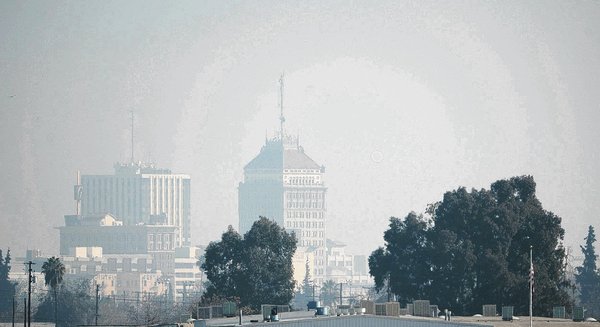Podcast: Play in new window | Download
Subscribe: RSS

No,it’s not Beijing, but downtown Fresno on Friday, January 17, 2014. (Photo by Craig Kohlruss/The Fresno Bee)
In the headlong race to see which city or region of the United States will generate the first wave of climate refugees, a race long dominated by Las Vegas NV and Phoenix AZ, California’s Central Valley has suddenly become a contender. It’s not just that the drought is becoming unbearable in this near-desert that through the wonders of water engineering has become the lettuce capital of the country; now the air is becoming unbreathable. Just as the lack of rain has parched the earth and overtaxed the water pipelines, so too has it left the air unwashed, and with the enormous quantities of junk being emitted into California’s air, you don’t want that.
Governor Jerry Brown last week declared a drought emergency in the state. Last year was the driest California has ever seen, and this winter, so far, the months that are normally the wettest have been the hottest. The mountain snowpack, source of much of the state’s surface water during the summer, is at 15-20 per cent of normal. The state’s major water reservoirs are at or below half of their normal levels. The wildfire season began in January, if it ever went out of season at all, with a 1,700-acre fire in the foothills above Los Angeles.
You might think that the state of emergency and the dire warnings have ushered in Draconian controls on water consumption. Not really. The state’s residents have been asked politely to reduce their water consumption by 20 per cent. That ought to do it. Obviously, everyone is going to comply, especially when they reflect that industrial agriculture gobbles three-quarters of the state’s water. What’s a 20 per cent reduction in 25 per cent of the problem? Not much.
And in the Central Valley, where the rain hasn’t come and the wind can’t whisk the smog and smoke away (ringed as it is by mountains), air pollution has reached epic, Beijing proportions. Residents haven’t been able to see the mountains for the last month. Their eyes watering and throats burning, they are being told by their government to stay indoors. The schools are flying red flags to warn of unhealthful air — because they never bought any purple flags, which they should be flying, to warn of very unhealthful air.
Maybe it will rain in California, and bring a respite. But all the long term trends indicate that if relief comes at all it will be short-lived. A major portion of the country’s food supply (especially produce) is teetering on the edge of sustainability while its air quality challenges breathability. Can depopulation be far behind?
[UPDATE: But wait! Is that Phoenix, coming up on the outside in the final turn? See “How Phoenix is Getting Ready for 100-Degree Nights.” Also “Phoenix Falling.”]
[UPDATE 02/01/14: No, California is holding on. The State Water Project has cut to zero the water it provides to 29 local water agencies (serving 29 million people) and to 750,000 acres of Central Valley farmland. While this does not necessarily mean that the agencies and farms are without water, it is a serious and unprecedented hardship.]